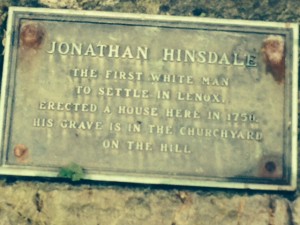
A plaque across from Hawthorne Street celebrates the location of the first settler of Lenox – Jonathan Hinsdale. It was, for a long time, the primary north-south route to Stockbridge and it has beautiful views. So it is not surprising that this street was a major location for beautiful homes – in the early days up to today. Some remain, some are gone.
Rev. Justin Field House
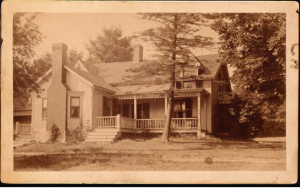
Not a “cottager”from a wealth stand point, but an important figure in Lenox’s Gilded Age era, Rev. Justin Field was a long-time (1862-1890) rector of Trinity Church and a leader in constructing the new church on Walker.
The space was also used as a boarding facility for students of Elizabeth Sedgwick’s school — including young Jenny Jerome (future mother of Winston Churchill).
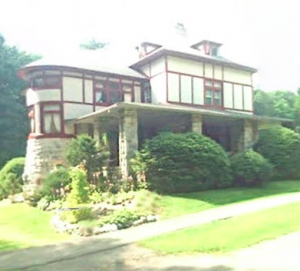
In keeping with the newly robust and wealthy congregation, the space was upgraded to the Tudor-like structure that stands today at 20 Old Stockbridge Road as a private residence. In 1892 a new rectory was built on the Trinity Church grounds.
Miss Lippicott’s School
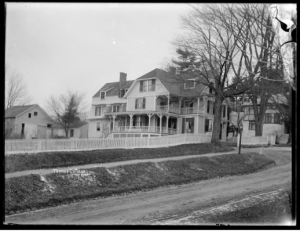
The building that still stands today as privately owned condominiums, was similarly, a re-work of an earlier structure and a facility for wealthy visitors. It has also been referred to as Tanner Cottage.
Moved and Changed
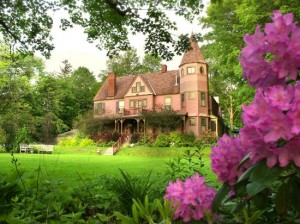
One of the first buildings you encounter on Old Stockbridge Road, now the Rockwood Inn, began life elsewhere. It was known as the Williams Tavern in 1825 and was located where Main and Cliffwood now meet. It would have been one of many taverns that did a land office business during Lenox’s busy court days.
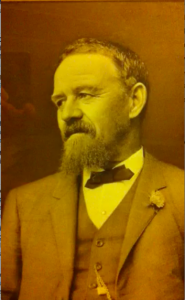
Around 1880, the building was purchased by Leonard Constance Peters who started a number of successful businesses in Lenox. He added the Victorian front of the building in the late 1880s. As with many successful Lenox businesses at the turn of the century, he catered to the estate owners by providing lodging for their secretaries and horses for hire.
Redwood
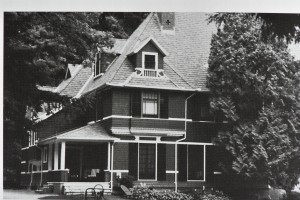
Redwood was built about 1880 for S. Parkman Shaw. Later owners used the name Beechknoll.
Beaupre – Gone But Not Forgotten

George and Elizabeth Turnure built Beaupre in 1902 roughly where Turnure Terrace stands today. The house picture here reflects alterations to an 1867 structure. The 1961 fire was thought to have been caused by some Windsor School students.
George Turnure was a New York banker and the father of a 21 year old WWI flying ace. His son was killed and, in his honor, George built the Lenox Brotherhood Club on Walker St. that would become the Lenox Community Center.
Lithgow – Gone and No Photos
This described in David Woods’ Lenox Massachusetts Shire Town (1969) as being on the west side of Lanier Hill on Old Stockbridge Road. The house (apparently extant at that time) is dated to the late eighteenth century although “modernized” in 1870 by Alfred Gilmore.
Burton Harrison House
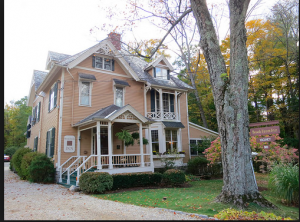
In another example of cashing in on resort development, Frederick Rackemann bought a local farm in 1882 and constructed this house for rental. Rackemann was married to Elizabeth Dwight Sedgwick and lived at the Hive.
The first tenants were Burton Harrison and his wife Constance Cary Harrison. The cottage became known as “The Burton Harrison House.”
The Harrisons were originally from Richmond, Virginia. Burton Harrison served as the personal secretary to President Jefferson Davis. Constance was a direct descendant of Thomas Jefferson. After the Civil War the Harrisons moved north and became prominent members of New York society.
How Our Inn’s Berkshires History Is Tied to the Statue of Liberty
Like many of their contemporaries, the Harrisons chose to leave the city for the summer season. They rented the Lenox cottage and entertained their friends there. Guests included the Andrew Carnegies, Dr. Oliver Wendell Holmes, and the poet Emma Lazarus. Constance was a popular novelist and playwright. She enlisted some of her friends to act out parts of her plays in the library of the Lenox house.
In 1883 Constance chaired a fund-raising art exhibition. A statue was being given as a gift to the people of the United States, from the people of France, and New Yorkers were busy raising funds to construct a pedestal for the statue. Constance joined in this effort by gathering a portfolio of original literary works by leading American authors, which she planned to auction at the art exhibit. Constance asked her friend Emma Lazarus to write a sonnet for the occasion. Lazarus, a member of the Harrisons’ New York set, had been doing volunteer work at a Lower East Side settlement house. Constance suggested that Emma use that as inspiration and several days later received a copy of the famous poem
Frederick Rackemann died in 1900, and to his butler, James Whittenham. Whittenham was in the odd position of having the building, but no property on which to situate it. He purchased real estate on Hawthorne Street from Bertia Parsons, the widow of Julius Parsons. The cottage was moved down the hill, and found a permanent home at 15 Hawthorne Street. It is currently operated as a bed and breakfast.
Parenthetically, on its way down the hill, the house passed the famous elm tree where a fatal sled accident had occurred. Lenox resident Edith Wharton later based her novel, Ethan Frome, on the accident. The tree was eventually removed, but a grassy triangle still marks the spot at the intersection of Old Stockbridge Road and Hawthorne Street.
It was purchased in the 1970’s by Ruth Backes, a direct descendant of Ralph Waldo Emerson. Her family history is important because Emerson was involved in the original Brook Farm, a utopian cooperative community of the 1840’s; Ruth Backes changed the name of the inn to Brook Farm Inn. Nathaniel Hawthorne was also involved in the original Brook Farm, and based his novel, The Blithedale Romance, on his experiences there. How ironic that the inn is located on Hawthorne Street!
(from Brook Farm Inn website)
Plumstead
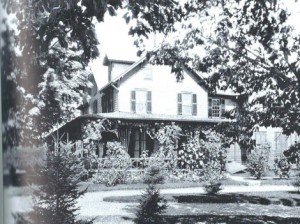
A jail was among the needs Lenox had when it was the county seat (1784 to 1867). Plumstead was the first site of the jail and the jailer’s house. The jailer is also described as owning Blossom Hill Farm. Part of the structures were burned down by a prisoner in 1814. By the late 19th century
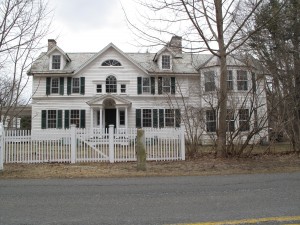
Queen Anne style angles had been added and one of two Lenox Whistler’s had moved in. Joseph Whistler and his brother Ross (who purchased a house on Greenwood (now known as Whistler’s Inn) were nephews of James McNeil Whistler and grandsons of the famous “Whistler’s Mother.”
The Bishop Effect
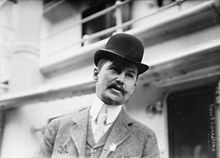
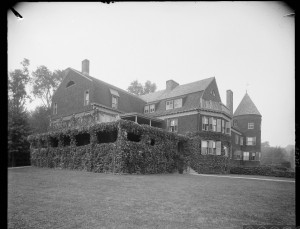
Cortland Field Bishop (1870-1935) drove fast cars, invested in the Wright Brothers, wrote about history and collected books. Like several of his Lenox estate owning counterparts, both his father and mother came from wealthy families. His brother David committed suicide in 1911 and the entire family fortune came to Cortland. He used part of his fortune to buy up a number of properties in addition to those he inherited. His properties surrounded Bishop’s Estate (running from Old Stockbridge Road to Kemble Street across from Canyon Ranch) plus further up OSR (across from Elm Court) Interlaken. He razed The Perch(off Kemble) and built the Winter Palace
He razed Yokun Farm on Old Stockbridge Road and built Ananda Hall in 1927 (demolished 1940)
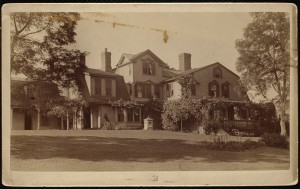
The original house on Yokun Farm had been built by the William Walker family (one of three Lenox properties William Walker owned) and passed to the Goodman family — perhaps after the Walkers moved to their house in town.
Ananda Hall was razed shortly after Cortland died and only a rock wall remains on Old Stockbridge Road. The Winter Palace he had built off Kemble remains. The Bishop family also built two houses (for all those overflow guests!) on Walker Street that stand today.
The rest of the former and standing estates start bleeding into Stockbridge, but their owners probably would have socialized toward Lenox.
Allen Winden
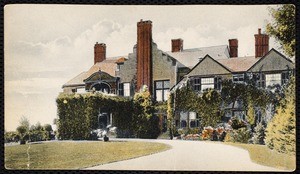
Allen Winden was built next to where Yokun Farm had been and had a spectacular view. The house, apparently named for a town in Switzerland, was built in 1882 by Charles Lanier (1837-1926) and Sarah Egleston Lanier (1837-1898).

Sarah was a descendant of Azariah Egleston, one of Lenox’s Revolutionary War heroes and early town leaders. Lanier, a banker and investor, lived the good gilded age life with lavish hunt breakfasts and weddings in Lenox plus membership in the famous Georgia Jekyll Island Club and J.P. Morgan’s Corsair Club. Good thing – since J.P. Morgan, a frequent business partner, had to bail Lanier out a couple of times.
The elaborate house was demolished, after Lanier’s death, in 1926 and replaced by a plainer Henry Seaver design. The elaborate landscaping was divided up into lots and it is now the Winden Hill Condominium complex.
Elm Court
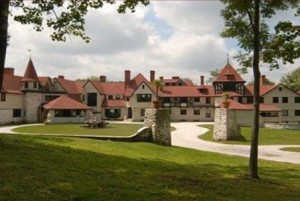
This shingle style spectacular was another product of two fortunes marrying. The original house was much smaller than the 90 room final product. Designed by Peabody and Frederick Law
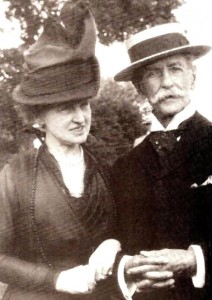
Olmsted, it was commissioned by William Douglas Sloane (1840 – 1915) and Emily Vanderbilt Sloane (1852-1946). He was the son of the prosperous Sloane furniture business and she was the granddaughter of Cornelius Vanderbilt.
Miraculously, the property has survived and the current owners are seeking approval to build a luxury hotel around the gilded age complex.
Overlee

Down the road toward Stockbridge, Samuel (1868-1923) and Elinor (1873-1961) Frothingham built Overlee in 1903. As with so many of its wannabe Elizabethan counterparts in Lenox, Overlee replaced a shingle style home called Glad Hill (no pictures). While
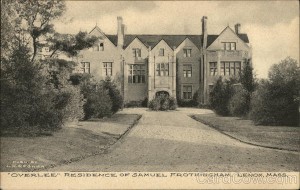
Overlee was being built the Frothinghams stayed at the Poplars across Old Stockbridge Road (also no pictures). As the hunt club gather shown above suggests, the Frothinghams were avid athletes and were active in the hunt club, golf and gardening.
Before settling into its current role as the Hillcrest Educational Center, it had been, along with so many other former estates, a boys’ boarding school.
Merrywood
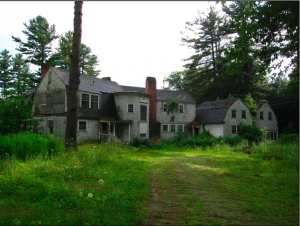
Colonial Revival Merrywood was built in 1882 by Peabody and Sterns for Charles Bullard (1857-1911). He had grown up at Highwood and was the son of East India merchant William s. Bullard.
For awhile it was operated as a Music Camp. Its fate is uncertain.
Poplars

Known to have existed near Bean Hill Road (the Frothinghams lived here prior to the construction of Overlee) but limited additional information.
———————
For much more on the architecture of these houses and the people who lived in them, see
Houses of the Berkshires, 1870-1930, by Richard S. Jackson Jr. and Cornelia Brooke Gilder, Acanthus Press, 2006
The Berkshire Cottages, A Vanishing Era, by Carole Owens, Cottage Press, Inc. 1980
